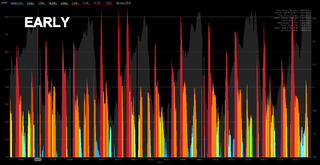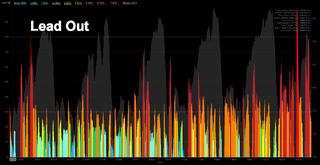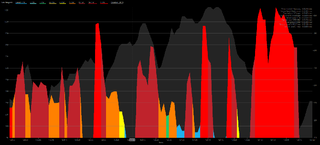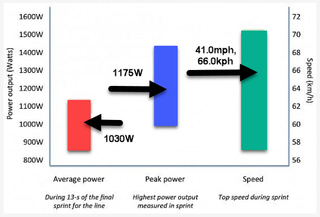Analyzing Cory Williams' winning sprint at the Crystal Cup
Guest columnist, coach Adam Mills shows how important the lead-out is







Cory Williams suffered a tragic GoPro failure during his victorious ride at the Armed Forces Cycling Classic Crystal Cup, so there won't be a video blog entry. But we have the next best thing: an expert analysis of Williams' sprint power data by his coach Adam Mills of Source Endurance.
There is zero chance or randomness in a field sprint. In fact, the term "field sprint" is misleading. What we witness isn't a field sprint but more like a handful sprinters having at it with the remaining riders following and incorrectly believing that they have a chance. It is no coincidence that we would all pick the same five riders to compete for a three-up podium in a Tour de France field sprint. To that end, we would all pick the same five climbers to compete for a three-up podium on a climbing stage. Sprinters are specialists and taking a sprinter to a bunch gallop is akin to believing that a non-climber can win a mountain top finish. Statistically, it just doesn't happen.
Sprinters are the rockstars of the peloton. They're the ones we all aspire to be, but likely never can be. They are always confident, usually cocky, and undoubtedly the best closers in the race. They also are the ones with all the pressure and the ones clubs build entire teams around.
Cory Williams of Elevate- KHS Pro Cycling is a closer. In 2018, he's the winningest rider on the team and he relishes the pressure and the sprint. Last week, he came away with a win at the Armed Forces Classic and we're going to take a look at his performance.
Armed Forces Cycling Classic: Crystal Cup

With WKO4 software from Training Peaks, we can examine data in limitless ways. The view here shows the entire race with any effort higher than Cory's FTP in yellow and any output great than 150% of his FTP is in red. Effectively, this is a good way to see when "matches" are being burned. There are a few key points I want to make here. First, is that many of the matches are similar in intensity and length. This is indicative of accelerating out of corners and not from any commitment in the wind creating moves or bridging. Second; the frequency of the spikes decrease as the race continues.
Fatigue begins to show itself by a notable decrease in frequency of high intensity efforts. We see this across all sports. Tired athletes don't like to make explosive efforts. However, in this case I believe that Cory is not succumbing to fatigue but rather benefiting from it.
The tight proximity of efforts early in a race is something we expect from a technical criterium due to the benefit of staying in the front. Maintaining that position requires a balance of throttle, maneuvering, and decision making as Cory leverages speed and utilizes course features and other riders to hold a favourable position. As the peloton fatigues, there are fewer challenges to position and the frequency of matches burned will subside. This typically happens about at about 60-70 minutes of a Pro-1 criterium.
The Lead Out


Something incredibly interesting happens between the 82- and 90-minute mark of the race. Cory stops making big efforts, while the speed of the race stays consistent. We've now entered the Lead Out phase of the race. Last year, we wrote an article about Cory where we were able to analyze the implications of simply being in a protected position and allow the team to help him.
However, the protection afforded Cory thanks to the superb work of his Elevate- KHS Pro Cycling Team in this race was at an entirely different level. As Dr. Ross Tucker from Science of Sport writes, "Also, a good lead-out train seems to facilitate the last kilometres of competition with a smooth ride, compared to a more stochastic ride for sprinters that have to find their way in the bunch alone". This lead-out was, in a sense, textbook. Let's have a look at the 0:09:15 lead-out compared to the first 0:09:15 of the race, but in a heat map format…
Cory makes very few big efforts in that key time frame, including accelerations out of corners. This is a sprinter's dream scenario.
Last Lap
You'll notice lots and lots of extremely polarized action here. Cory is either pedaling at a very high intensity, or coasting. This is the playground of a world-class sprinter and, while it only lasts for a handful of seconds (1:55), it's amazing to watch and interesting to analyze. First, the high power efforts in the last lap are all part of an intricate balance of position, patience, conserving, and burning to maintain a position capable of winning the race. In some ways, the last 2-4 minutes of a race are the most stressful for sprinters and Cory has even told me he likes it when they turn the final corner because, "then, all I have to do is run to the finish line."

Examining the sprint is always something Cory and I enjoy. It's always a treat when I can be a part of a world-class performance and this is exactly that. The final sprint, in its entirety, was a scant 18 seconds. But in those 18 seconds, Cory made a few key decisions that led him to win the race by coming from 3rd wheel. Such a feat is rare and to do it while every sprinter is accelerating is even more impressive. To start, Cory needs to negotiate the last turn at a speed well above 30mph (blue) (GPS systems don't handle speed at turns particularly well). Next every sprinter instantly accelerates to top speed as fast as possible knowing that every metre closer to the finish line makes it exponentially more difficult to pass. Here is where we see an "easing" of output from Cory. Cory was simply gaining too fast on the leaders and needed to change the timing of his sprint ever so slightly. So, he "eased" over the next 3-4 seconds from 1070W (yellow) to 680W and back to 950W before reigniting the afterburners at his maximum output of the day, making the pass and winning the race.

But how does that sprint measure up against a Grand Tour sprint by the world-class sprinters? I've adapted this chart from Dr. Tucker and overlaid Cory's 13 second sprint data so we can make a direct comparison. We have, without a doubt, a world-class sprint and it was a great one to watch!

References:
Menaspà, P., Abbiss, C. R., & Martin, D. T. (2013). Performance analysis of a world-class sprinter during cycling grand tours. International Journal of Sports Physiology and Performance, 8(3), 336-340.
Menaspà, P. (2015). Analysis of road sprint cycling performance (Unpublished doctoral dissertation). Edith Cowan University, Joondalup, Australia.
Tucker, R. (2016, August 05). The profile of a sprint: What does it take to win a sprint stage?
Get The Leadout Newsletter
The latest race content, interviews, features, reviews and expert buying guides, direct to your inbox!